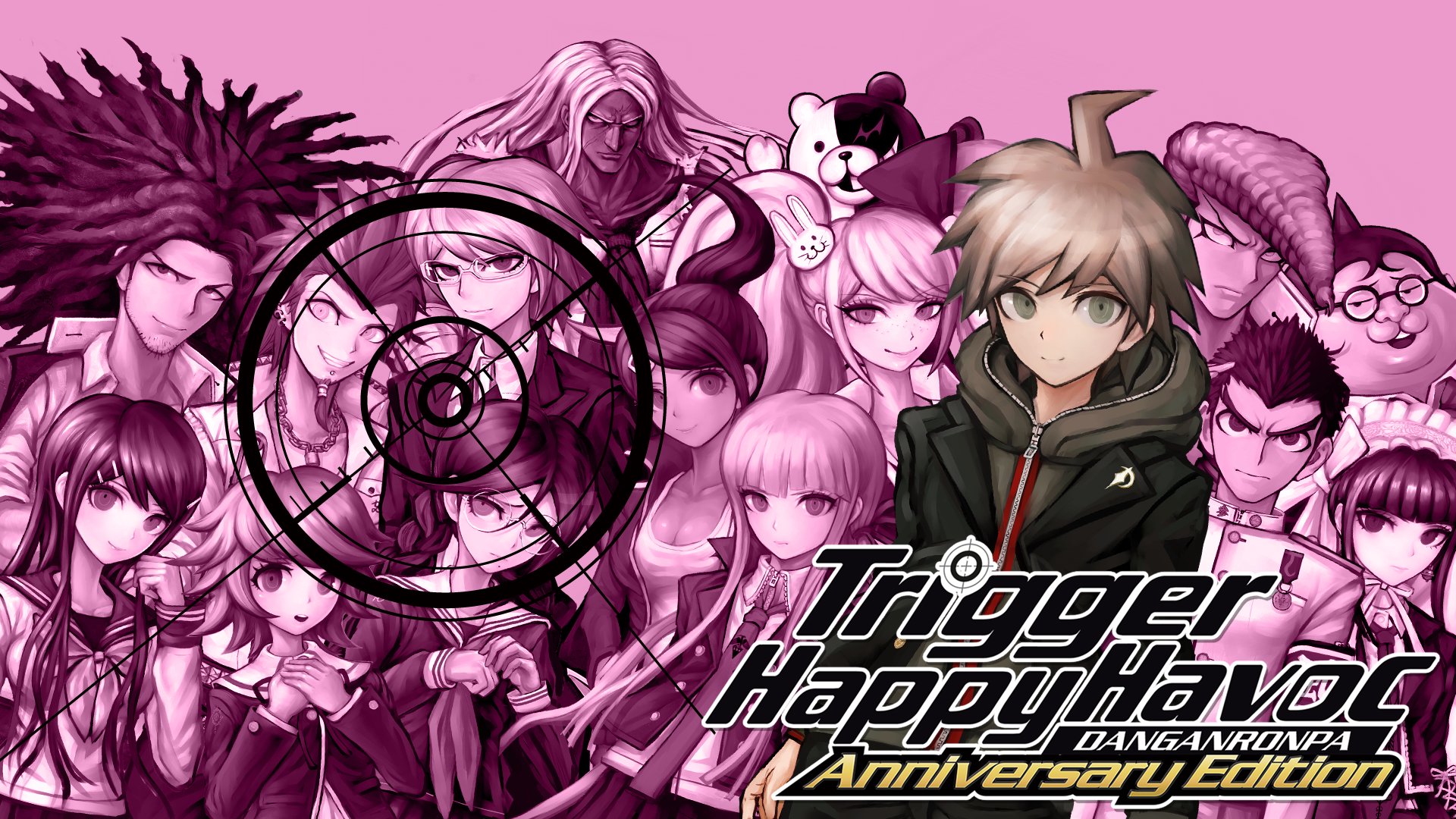
Gaming Editor Louis Wright reviews Danganronpa stating that it succeeds thanks to its uniqueness as a visual novel
Visual novels centring around murder mysteries are a surprisingly common brand for gaming. Ace Attorney, Famicom Detective Club, and even Professor Layton at times all fall under this category. With so many options available to players, it is important for a debuting series to carve a niche within the genre in order to stand the test of time and prove successful amongst the existing titans.
Danganronpa is a game that manages this. Everything about not only the first instalment, but the series as a whole, is oozing with a unique flair that is not only brilliantly executed but oddly fitting for the tone and content for the game.
Excellent EXECUTION of Exposition
Visual novels like Danganronpa live and die by their narrative. Typically minimal on gameplay and dense on story, the genre is reliant on being well written and engaging with its dialogue to hook audiences and keep them playing. More than most other games in the genre, Danganronpa presents a brilliantly crafted narrative.
Visual novels like Danganronpa live and die by their narrative
Exploring the conflicting yet intertwining nature of hope and despair, Danganronpa is a thematically dense story that defines the nature of humanity in the face of adversity. Even in the face of ‘Ultimate Despair’ as long as there is a persistence of hope then humanity, in some regard will survive. Likewise, even with the existence of an ‘Ultimate Hope’ despair perpetuates to provide a meaning and reason to push forward.
The game purposefully leaves certain elements of its story’s contextualisation to audience interpretation. This ambiguity reinforces the meaning of hope and despair within the story, leaving players to decide whether they believe in a world of hope or a world of despair, mirroring the finale of the character’s arcs within the game. Immersing the audience in this sense gives the game a level of nuance that is rarely seen.

Backed by consistently clever and subversive writing (a necessity for a game steeped in murder mystery) the game is entertaining in its story’s presentation. Technically satisfying, it is properly paced, draws the player in with its mystery, and has satisfying payoffs at the climax of each chapter. While it can suffer from being too reliant on certain tropes of anime-inspired media, the story is structured in a way that encourages continued play.
Danganronpa sees further success in its character driven nature. Every member of its cast is distinct in their identity, supported by all being the ‘Ultimate something’, and dialogue. Being introduced to 16 characters immediately is a daunting prospect when starting the game, but the way each one is made to be unique the player is eased into the expansive cast.
A HIT on the Gameplay
Like most games of its ilk, Danganronpa splits its gameplay into an investigation of the murders that take place within its narrative and the trial where the player must find the truth. However it separates itself from these other games by introducing extra elements that provide another layer of depth, and, ultimately, prove to make the game more engaging.
Primarily, this deviation from the standard is seen in the pre-investigation period, or ‘Daily Life’, of each chapter
Primarily, this deviation from the standard is seen in the pre-investigation period, or ‘Daily Life’, of each chapter. Allowing the player to explore the school setting at their own leisure and interact and spend time with the variety of characters without worry of solving the current murder provides a much needed opportunity for character development. This allows a more complex side of the characters to be uncovered by the player and therefore become more invested when a murder does happen, for the hope that a character they have bonded with is the victim or perpetrator.
When a body has been found and the chapter turns to ‘Deadly Life’, the investigation of the crime commences. This turns Danganronpa from an effective dating sim into a point-and-click adventure where clues to the murder are unearthed. While adhering to the genre norms, the investigation is streamlined to the point where it does not become boring and provides ample opportunity, pre-trial, for the player to understand the nature of the mystery before them.

Where Danganronpa truly shines however are its ‘Class Trials’. Truly unique in its presentations of court trials, gameplay is split between different modes utilising various skills and techniques, none of which fit the standard mould for the genre.
Truly unique in its presentations of court trials, gameplay is split between different modes
‘Non-Stop Debates’ are fast paced conversations that are framed as a first-person shooter where the player must shoot the correct statements with ‘Truth Bullets’ to present evidence. ‘Hangman’s Gambit’ has the player put into a game of hangman, having to shoot letters to form a word relevant to the case. ‘Bullet Time Battles’ transform the game into a rhythm game where aiming, shooting, and reloading must be done in time with the beat to defeat the opponent’s argument. Finally, ‘Closing Arguments’ allow the player to fill in the blanks of a stylised comic that presents an overview of the entire murder the trial centred on.
All of these variations of gameplay and deviations of the genre are not even including the bonus side-mode unlocked upon completing the game: ‘School Mode’. Acting as a simple resource management game, and dialling the basic dating-sim elements up 10-fold, it turns Danganronpa into an even more addictive time sink.
An Absolute KILLER Sound Design
Catchy soundtracks are commonplace amongst the Japanese gaming market. Most of Nintendo’s library has iconic themes, Persona 5 is full of swing jazz and funk, and the likes of Street Fighter is capable of covering multiple genres in a single game. Danganronpa is no different in this regard as its soundtrack is not only full of earworms, but genuinely enjoyable.
Consistently utilising electro-funk as a base genre and incorporating leitmotifs throughout its pieces, the soundtrack comes together to form a cohesive body clearly defining one game. This definition is arguably one of the strongest points of the soundtrack, as its styling and incorporation of singular spoken words in beat drops becomes iconic and instantly recognisable to the game.

While the soundtrack may be iconic however, the sound effects find themselves distinctly lacking in this department. Sound effects are repetitively used and from common sources, meaning they are shared with many other games on the market. This results in a lot of sound effects being not only generic but glaringly lacking in an identity similar to the rest of the sound design.
The generics found in some aspects of Danganronpa’s sound design does not carry over to the voice acting. While not all lines of dialogue are voiced, those that are are done purposefully for impact and well directed. The English voice cast are decisively suited to their roles and bring the characters to life, representing the individuality of each. This is especially prominent towards the end of the game where the performances easily become their strongest.
These Graphics SLAY
As a visual novel, Danganronpa presents itself through primarily still images and character portraits. While simple in design and execution, the game’s graphics serve an effective purpose in not only communicating the necessary information on the characters and environments, but also in a charming style.
Being set in a school, there is boundless potential for areas that the player can explore
The simplest part of Danganronpa’s art design is in the aforementioned character portraits. These follow a traditional anime-inspired art style which conveys character emotion and provides a solid interface for the audience. While basic in concept they act as a good bridge for the more extravagant and inimitable elements.
One such element is Danganronpa’s environments. Being set in a school, there is boundless potential for areas that the player can explore, and this is taken full advantage of. A botany garden, feudal-Japan dojo, futuristic data centre, Olympic-sized pool, and even a morgue feature throughout providing for a range of unique aesthetics to be taken advantage of.

What really makes these environments distinct however is their stylisation. By having the different elements of the area being designed as 2D illustrations placed in a basic 3D environment, even to the extent of popping up and unfolding when the area is entered, the game creates the impression of existing as a pop-up book. Reinforcing and embracing the idea of a visual novel simultaneously, Danganronpa succeeds in making locations distinct even when the entire game takes place in a single building.
Danganronpa, more than any other element of its existence, is most famous for the cutscenes present in the game. Especially seen with the ‘Executions’ taking place at the end of each trial, the game presents beautifully stylised and effectively animated cutscenes that not only translate the preexisting pop-up style to a more detailed manner, but in a way that is tasteful and tonally accurate to the content matter. These serve as memorable farewells to the characters being executed and cement the game’s niche.
Rating
8/10
Danganronpa proves itself as an unorthodox highlight of its genre. It takes the core concept of a visual novel murder mystery game and turns it on its head, while still keeping that core intact, that proves to create a riveting experience even for those well attuned to the genre’s stylings. It is easy to recommend to both newcomers and veterans, with the stipulation of being prepared for the strange tropes it can sometimes perpetuate.
Trailer
Danganronpa: Trigger Happy Havoc is available on Steam, Nintendo Switch, PS4, Xbox, and Mobile
Read more gaming reviews here:

Comments